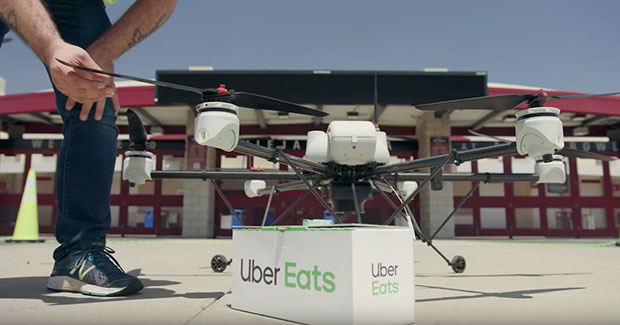Uber Elevate, the aerial arm of rideshare service Uber, last week announced that it will start a fast food delivery by drone test service later this summer in San Diego.
Delivery destinations won’t be houses or apartment buildings, however, but instead will be “designated safe landing zones,” according to reports.
Those landing zones could include the roof of a parked Uber vehicle in one scenario. An Uber courier would receive the package and hand-deliver it to the consumer.
McDonald’s is one of Uber’s partners, and it has been developing special packaging to keep food hot and intact during the aerial portion of a delivery.
Look, Up in the Sky
When Uber Elevate’s drone delivery actually would take flight has been up in the air for some time. The Federal Aviation Administration only granted its approval last week. The FAA has designated San Diego as one of the 10 U.S. locations for the testing of commercial drone service.
The southern California city has become a hotbed of drone research, partially due to the military presence there but also thanks to weather that is reliably sunny and calm, ideal drone flying conditions.
Yet even when Uber Elevate is able to get its drone program off the ground later this summer, it likely won’t maintain its air supremacy for long.
Walmart reportedly has filed more drone patent applications than Amazon for the second year in a row. However, Wing Aviation, which is owned by Google parent company Alphabet, in April announced that it also has received certification from the FAA to begin delivering small packages in two rural Virginia communities near Blacksburg.
It’s a Drone
Given that drones will be subject to many restrictions –no flying over densely populated areas, for example — it’s not clear what advantages they offer over other delivery methods. However, delivery could be just one part of the role drones play in the near future.
“Drones are for real in key areas of the supply chain — checking inventory levels in huge distribution centers, flying manufacturing lines to determine when new parts are needed on the line, inspecting far-flung facilities and pipelines,” said Ted Stank, faculty director and professor of logistics at the University of Tennessee Global Supply Chain Institute.
“It is coming — otherwise, Amazon, Walmart, Uber, Google, etc., would not be pushing it so hard,” he told TechNewsWorld.
“Still, I just don’t see it happening soon. There are too many legislative and regulatory issues to work through before it can scale to any kind of volume,” Stank added. “For the short term, I think more of a novelty in terms of last-mile delivery of products.”
Drone On
Even as drones are tested in San Diego and Blacksburg, another potential use in the near term is the delivery of medical items in areas that are difficult to reach by car or even on foot.
“There may be some application for extremely high-value products or highly perishable ones or having to get to very difficult-to-reach locations,” said Stank.
U.S. startup Zipline is already utilizing drones to make blood deliveries to remote hospitals and aid stations in Rwanda, for example.
“Using drone technology for humanitarian and commercial purposes as opposed to just recreational ones is inevitable; there is just too much potential to ignore,” said James R. Bailey, professor of leadership at the George Washington University School of Business.
“To human welfare, imagine delivering a vasodilator to someone suffering an angina episode in half the time it would take an ambulance to arrive,” he told TechNewsWorld.
The same could hold true for the delivery of food and supplies to an isolated village after a tsunami or other disaster, explained Bailey. “Such applications will enjoy widespread support.”
Clearing the Air
However, there are a number of issues and challenges that need to be overcome before drones will be making routine deliveries of Big Macs and Amazon boxes.
“First, how does the drone access an order effectively and efficiently? Can it do it automated, or does someone have to load it at cost?” pondered Stank.
Then there is the issue of liability.
“What if the drone crashes,” Stank continued, “or what if someone shoots it down to steal the order, which people have jokingly called ‘skeet shooting for prizes?”
For those reasons and others, “the flight path to commercial application will be more turbulent,” suggested Bailey.
“Anything can be hacked these days, including the signals flowing to drones, and the drones could be downed for the hell of it — hijacked for theft or cargo tainted,” he added.
“Mischievous boys could launch their own squad for aerial assaults or just throw rocks,” Bailey noted. “Such roguery could cause more chaos than malware. Public patience for business pursuits will be short and the legal ramifications tall.”
Coming In for a Landing
There are other issues as well, such as where drones could land. As noted, Uber Elevate is opting to have designated landing zones, such as on the cars of vehicles marked with QR codes. However, that might not be practical for all deliveries.
“Zipline literally parachutes the blood products onto hospital roofs in Rwanda, but that won’t work for most consumer goods,” said Stank.
Then there is the issue of returns or even stolen packages on the ground.
“Certainly, information technology [including] video camera feeds can address many of these issues, but can it be done at low cost? And can it be scaled for anything other than to make a cool impression and YouTube video?” questioned Stank.
“There are a lot of supply chain-related applications for drones that do not require last-mile delivery of products. I could foresee possible uses in ensuring compliance of Uber drivers in the passenger business, location and ID of shipments for Uber Freight, and any kind of role that requires visibility into parts of the supply chain that have typically been difficult to gain access to,” he added.
More Than Crowded Airspace
Another consideration is where exactly drone delivery could take flight. Some cutting-edge technologies — notably autonomous vehicles –seem poised for a rollout in urban markets, but as there are restrictions for flying over densely populated areas, cities such as New York and San Francisco don’t seem like ideal candidates for drones.
Thus drone delivery and self-driving cars aren’t likely to be complementary, and yet both technologies are being developed by the same companies. Then there is the issue of developing competition to provide quick and easy food delivery.
“Uber’s business model seems off. They already have countless drivers eager to swing by a McDonald’s to pick you up some burgers,” said Bailey.
“Grubhub and others do too, and delivery time in the food industry is in preparation as much as anything else — think about your last Chinese or pizza delivery,” he added.
“I get Amazon’s vision for drones, as Amazon has a comparatively small number of distribution centers,” Bailey pointed out.
“Thus, their drones can return to the same origination for another pickup, but there are thousands of restaurants in any urban area, and the margins on food are already razor thin, while the cost of a drone fleet will raise prices above consumers’ sensitive purchase point,”he explained.
“Is it scalable and affordable? And can regulatory and legal issues be resolved?” wondered Stank.
For many of those reasons, it is more likely that drones could fill a void in rural rather than urban markets.
“To make a delivery to a rural location is very expensive — there is no density of demand and distances can be long, both increasing the cost of sending a driver in a vehicle to a rural location to deliver one order very costly. Thus sending a drone makes a lot of sense,” said tank.
“In addition, since the drone will not be transiting through populated areas for the most part, the legal and regulatory issues, as well as the challenges of safe operation, should be far less than in an urban area,” he noted.
All of these points could be moot, as the final decision on where drones can make delivery rests with the FAA.
“Although some testing sites have been approved, the Federal Aviation Authority won’t be granting business licenses anytime in the near future,” said Bailey. “The U.S. has among the safest national airspaces on the planet. They’re not going to compromise that for one-hour delivery of a Big Mac.”























































